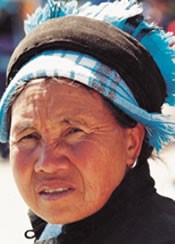The suffix jia is a Chinese term meaning "household" or "family." The Longjia should not be confused with the 1,300 Long people who are a Yi group living in Huaning County of Yunnan Province. The Longjia share no historical or ethnic relationship with the Bai people of Yunnan. Their inclusion in the Bai minority was one of convenience for the government. Although they did not want to place the Longjia in a group which it would offend them to be part of, the authorities firmly oppose official recognition of small groups like the Longjia.
The Longjia were once a large group in western Guizhou before they were assimilated into the Han Chinese culture and language. In the 27th year of the Yuan Dynasty (1298) the Longjia numbered 46,000 families.
The Longjia ethnic group includes some members of the Nanjingren group. These two peoples have lived alongside each other for many centuries. They have become so intermixed that it is difficult for outsiders to distinguish one group from the other. Today, the Longjia wear Han clothing and speak Chinese. The Longjia have something of a bad reputation among their neighbors; they are known for their violence and drunkenness.
Ancestor worship mixed with animism are the main religious beliefs among the Longjia. Every year they hold a bullfighting ceremony which has many religious rituals attached to it. The people finally sacrifice the animal as an offering to the spirits of the harvest, the spirit of the water, village, etc., and they ask the guardian spirits to watch over their community in the coming year with blessing and protection. In Longjia culture, a family's wealth is measured by the number of water buffaloes and cows it owns.
Though there are many Christ followers among the Longjia, there is a lot of work needed before they can be fully reached.
The Longjia would best be reached today by using Chinese-language scriptures and other evangelistic tools. Pray for these tools to be easily available and understood.
Pray for the Holy Spirit to move mightily among Longjia family leaders.
Pray for the Longjia people to have the spiritual hunger it takes to embrace Christ no matter what the cost.
Scripture Prayers for the Longjia in China.
Operation China, Asia Harvest, Copyrighted © Used with permission
| Profile Source: Joshua Project |










